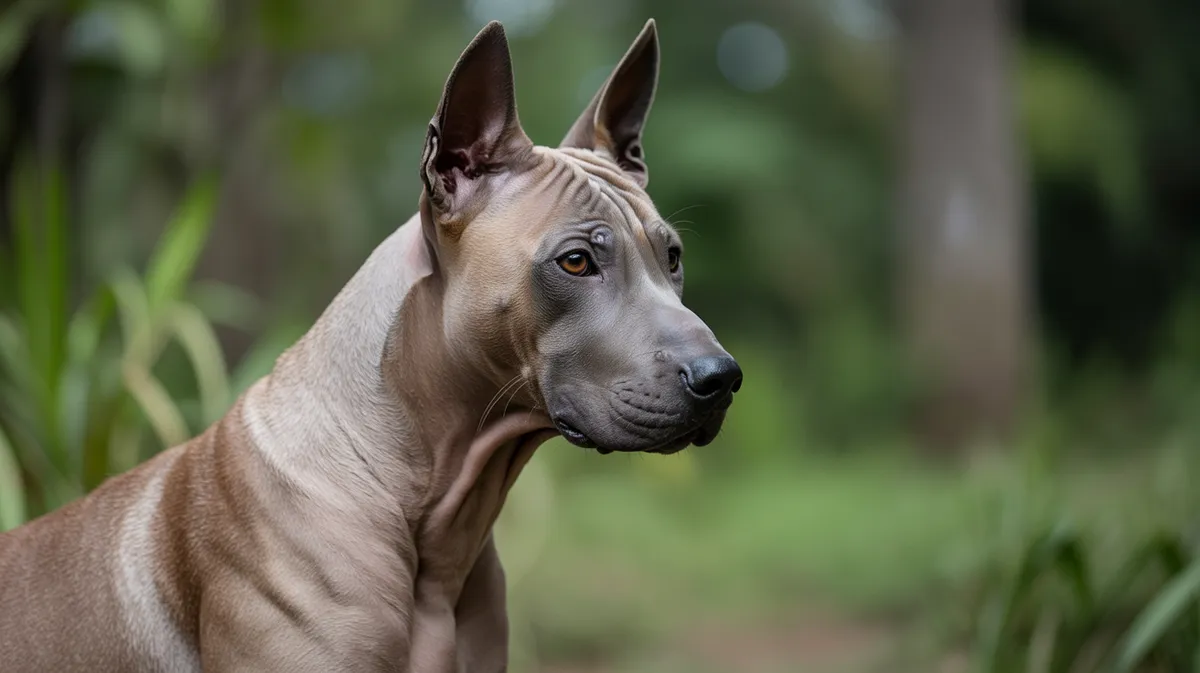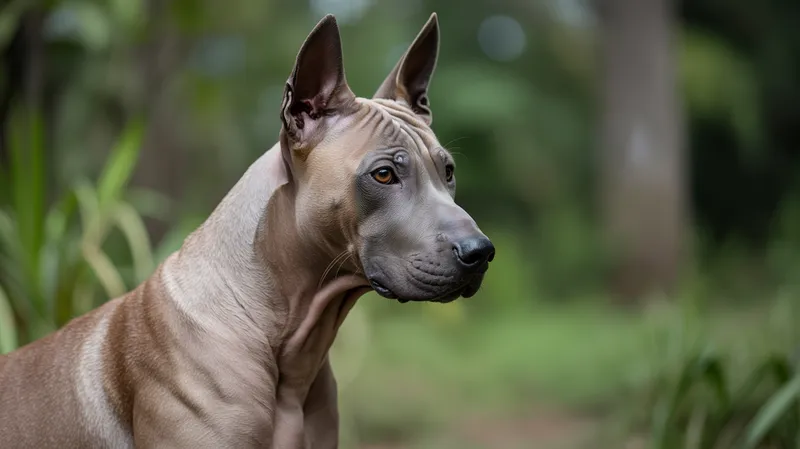
Thai Ridgeback
Canis lupus familiaris

Meet the Thai Ridgeback
The Thai Ridgeback is a medium-sized, muscular dog breed known for the distinctive ridge of hair growing in the opposite direction along its back. Native to Thailand, it was originally bred for hunting and guarding, with a history dating back several centuries. The breed is highly intelligent, agile, and independent, making it both a loyal companion and a vigilant watchdog. Thai Ridgebacks have short, smooth coats and come in several colors, including red, black, blue, and fawn.
Classification
Mammal
Habitat
Domestic, rural, and semi-rural environments
Diet
Omnivore
Lifespan
12-16 years
Conservation
Least Concern
Weight
16-34 kg (35-75 lbs)
📖Fascinating Facts
Unique Ridge
The Thai Ridgeback's defining feature is a ridge of hair along its back that grows in the opposite direction to the rest of the coat, creating a distinct pattern.
Athletic Build
This breed is remarkably agile and energetic, originally bred for hunting and capable of jumping great heights.
Thai Heritage
The breed is native to Thailand and has been used as a guard dog, hunter, and companion for centuries, remaining a national treasure in its homeland.
📋Detailed Description
The Thai Ridgeback is a medium-sized, athletic dog breed distinguished by a prominent dorsal ridge—a strip of hair along the spine growing in the opposite direction to the rest of the coat. This ridge is a defining trait, with eight recognized ridge patterns, and is genetically unique to the breed. Adult males typically stand 56–61 cm (22–24 in) at the shoulder and weigh 23–34 kg (51–74 lb), while females are slightly smaller at 51–56 cm (20–22 in) and 16–25 kg (35–55 lb). The breed has a wedge-shaped head, erect ears, and almond-shaped eyes, contributing to its alert expression. Its short, smooth coat comes in solid colors—red (often with a black mask), black, blue, and fawn. Thai Ridgebacks possess a deep chest, strong limbs, and a flexible, muscular build, well-suited for agility and endurance. Anatomically, they have a scissor bite and a tail that curves upward, aiding in balance during rapid movement. Behaviorally, they are highly intelligent, independent, and sometimes reserved with strangers, but form strong bonds with their families. The breed is known for its keen senses, quick reflexes, and natural athleticism, making it adept at hunting, guarding, and navigating rugged terrain. Socially, Thai Ridgebacks are often solitary or form small family groups, displaying territorial instincts and a strong prey drive.
💡 Did you know?
Despite its ancient origins, the Thai Ridgeback remained virtually unknown outside Thailand until the late 20th century.
🔬Research & Sources
Wikipedia Summary
The Thai Ridgeback is a dog from Thailand. Its origins are in Chanthaburi and Trat provinces in the eastern part of Thailand. The Thai Ridgeback is one of only three breeds that has a ridge of hair that runs along its back in the opposite direction to the rest of the coat. The other two are the Rhodesian Ridgeback and the Phu Quoc Ridgeback.
Last Modified: 3/9/2025
🎭Behavior & Social Structure
Thai Ridgebacks are alert, vigilant, and naturally wary of unfamiliar people, making them excellent watchdogs. They exhibit strong territorial behavior and are known to be protective of their home and family members. Historically used for hunting wild boar, snakes, and other small game, they retain a pronounced prey drive and may chase small animals if not properly socialized. Their intelligence and independence can make them challenging to train, requiring consistent, positive reinforcement methods. Thai Ridgebacks are generally active, requiring regular physical and mental stimulation; they enjoy running, agility activities, and interactive play. Social interactions with other dogs can vary—some individuals are sociable, while others may be dominant or aloof, especially with unfamiliar canines. Daily routines often include patrolling their territory, engaging in play, and seeking companionship from trusted humans. They are known to be clean, often grooming themselves like cats, and can be reserved in new environments.
👶Reproduction & Life Cycle
Thai Ridgebacks are monoestrous, with females typically coming into heat once or twice per year. The breed does not have a defined breeding season, but in their native climate, breeding may coincide with the cooler, drier months. Courtship involves ritualized sniffing and play, with males often displaying dominance behaviors. The gestation period averages 60–63 days, after which litters of 5–10 puppies are born. Neonates are altricial, requiring extensive maternal care; the dam nurses and grooms the puppies, providing warmth and protection. Weaning begins at around 4–5 weeks, with puppies becoming increasingly independent by 8–10 weeks. Both sexes reach sexual maturity between 12–18 months. Responsible breeders select for health, temperament, and the presence of the characteristic dorsal ridge, as the gene responsible for the ridge can also be associated with dermoid sinus, a congenital skin condition.
🛡️Adaptations & Survival
The Thai Ridgeback’s short, dense coat and pigmented skin provide protection against the intense heat and humidity of Southeast Asia. The dorsal ridge is thought to be an evolutionary adaptation, possibly serving as camouflage or a deterrent to parasites, though its exact function remains under study. Their strong, agile bodies and flexible joints enable them to traverse rough, uneven terrain and leap barriers with ease. Erect ears and keen senses of hearing and smell enhance their ability to detect prey and intruders. Behaviorally, their independence and problem-solving abilities are suited to a semi-feral lifestyle, allowing them to survive with minimal human intervention. Their territorial instincts and wariness of strangers are adaptive traits for guarding property and livestock.
📚Research Sources
🎨Cultural Significance
The Thai Ridgeback holds the status of a national dog in Thailand and is deeply embedded in local culture. Historically, the breed was valued for its abilities as a hunting companion, guard dog, and protector against snakes and other threats. In rural communities, they were often associated with prosperity and good fortune. The breed appears in Thai folklore and traditional art, symbolizing loyalty, courage, and vigilance. In modern times, the Thai Ridgeback is celebrated as a living heritage, with breed clubs and enthusiasts working to preserve its unique characteristics. The dog is sometimes featured in cultural festivals and is recognized as a symbol of Thai identity.
🔬Recent Research & Discoveries
Recent genetic studies have confirmed the Thai Ridgeback’s ancient lineage, with mitochondrial DNA analysis indicating a distinct Southeast Asian origin. Research into the ridge gene (a duplication on chromosome 18) has identified its role in both the dorsal ridge and the predisposition to dermoid sinus, providing a model for studying similar genetic traits in other species. Ongoing studies are examining the breed’s behavioral genetics, disease susceptibility, and population structure, both in Thailand and among expatriate populations. Conservation geneticists are collaborating with Thai breeders to develop strategies for maintaining genetic diversity and reducing inherited health issues. The breed is also being studied for its unique adaptations to tropical environments, offering insights into canine evolution and domestication.
🎥Wildlife Videos

THE THAI RIDGEBACK - FIERCE GUARD DOG? ไทยหลังอาน
Anneka meets GOBLIN, one of the rarest guard dogs on earth - The Thai Ridgeback known for his strength, prey drive and ...
Animal Watch

Discovering the Unique Qualities of 3 Amazing Ridgeback Dog Breeds!
In this video, we'll explore the unique qualities of each ridgeback dog breed and their homelands. We'll learn about the ridgeback ...
Dogumentary TV

The Adventures or 3 THAI RIDGEBACKS
This video is about My Movie 80.
Michael George Parker (OMKO-THAI-RIDGEBACK)

Animal Magic for 3 Thai Ridgebacks!
This video is about My Movie 155.
Michael George Parker (OMKO-THAI-RIDGEBACK)

3 Thai Ridgebacks Encounter a SCORPION!
This video is about My Movie 161.
Michael George Parker (OMKO-THAI-RIDGEBACK)
🌍Habitat Information
The Thai Ridgeback typically inhabits Domestic, rural, and semi-rural environments environments. Thai Ridgebacks have adapted to their environments with specialized features and behaviors.
Primary Habitat:
Domestic, rural, and semi-rural environments
More detailed habitat information will be available soon.
🛡️Conservation Status
The Thai Ridgeback is currently classified as Least Concern. Conservation efforts are crucial for preserving this species for future generations.
Common Threats:
- 🏠Habitat loss and fragmentation
- 🌡️Climate change impacts
- 🎯Hunting and poaching
- 🏭Human-wildlife conflict
⚠️Threats & Conservation Challenges
While the Thai Ridgeback is not considered globally threatened and is classified as 'Least Concern,' the breed faces several challenges. In Thailand, population numbers are stable but localized, with genetic bottlenecks arising from limited breeding stock and inbreeding. The breed is susceptible to certain hereditary conditions, notably dermoid sinus and hip dysplasia. Urbanization and changes in land use have reduced traditional roles for the breed, leading to a decline in working populations. Internationally, the breed remains rare and is sometimes subject to irresponsible breeding practices. There are also concerns about the loss of genetic diversity as the breed gains popularity outside its native range. Conservation efforts focus on maintaining genetic health and promoting responsible ownership.
🔬Scientific Classification
Scientific Name
Canis lupus familiaris
Classification Hierarchy
🔍 About Taxonomic Classification
Taxonomic classification is a hierarchical system used by scientists to classify and organize living organisms based on shared characteristics and evolutionary relationships.
The system moves from broad categories (Kingdom) to increasingly specific ones, with each animal's scientific name typically consisting of its Genus and species.
📝Community Notes
Share your observations and insights about the Thai Ridgeback with our community of wildlife enthusiasts.
Join Our Community
Sign in to share your observations and connect with fellow wildlife enthusiasts.
Sign In to ContributeNo community notes yet
Be the first to share your observations about the Thai Ridgeback!
Explore Thai Ridgeback
Select a tab above to learn more about this amazing animal.
📸Photo Gallery
No photos available for this animal yet.
🌟Discover More Wildlife
Continue your journey of discovery with more fascinating animals from our database
